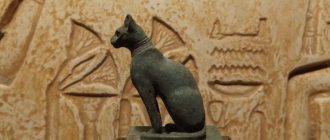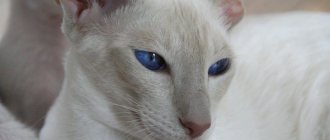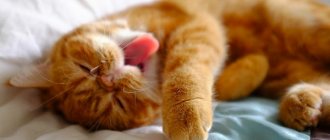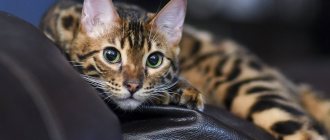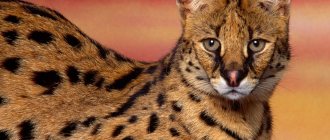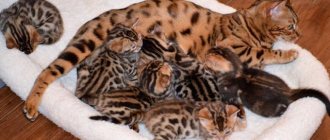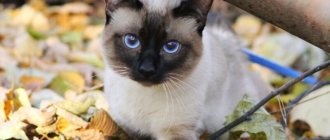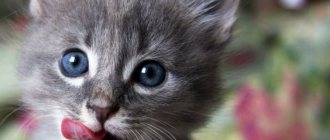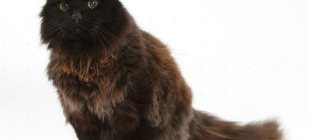Spotted color
The spotted color of the Bengal cat is the most popular color. If you have seen a Bengal cat, then most likely you have seen it in its spotted form. The brown spotted tabby color was recognized in Championship Status (TICA) in 1991.
Spotted Bengals have distinctive, small to medium-sized spots along the entire length of their body. Large, random, two-color rosettes are especially appreciated. This color in domestic cats looks like a mini-leopard. This style emerged when breeders believed that larger, sparser spots were more desirable. The original spotted tabby pattern found in domestic cats has been modified by selective breeding.
The coat is covered with random, diagonal or horizontally aligned spots on the body, belly and legs. Large dark spots on a light background are usually preferable.
Of course, there are variations in spotting, and one Bengal cat can have many different types of spots.
Single-Spotted
The spots are monochrome, one-color. These are simply solid spots splashed with droplets on a contrasting background, similar to wild cats such as Cheetahs or hybrid spotted cats (Ocicat, Egyptian Mau, Spotted Shorthair).
Bengals with solid spots are allowed to show, but are not preferred. Some breeders believe that they should not be allowed to compete.
The most popular spotted color for a Bengal cat is the Rosette Bengal. Spots are called rosettes when the spots are two-tone contrasting colors different from the background color. The Bengal cat is the only domestic cat with rosettes!
Rosettes in the Bengal breed began in the early 2000s, when some breeders bred the shade spots with darker spots. The rosette quickly developed.
When you see the evolution of the breed over the years, it is amazing to realize the progress that some rosette breeders have made in just a few decades.
The 3 most important types of socket:
– Arrow-head – Paw-print – Donut
Arrowhead sockets
The arrows may be solid and monochrome in one spotted group, or they may be a variety of colors that fade toward the background. Well-defined arrow rosettes are rare and popular among Bengal cat owners and breeders.
The arrowhead socket is not the most common, but it is probably the easiest type of socket to identify. Arrow rosettes are shaped like a triangle, like the tip of an arrow or teardrop, with all ends pointing toward the back of the cat.
Asian leopard cats have many different color types, but the arrowhead pattern is one of the most visually impressive. Arrow-shaped spots are excellent camouflage in the dim light of a forest habitat. With such fur, a cat that stands motionless on trees or in fallen leaves is very difficult to notice.
The Bengal cat breed standard requires the spots to be horizontally aligned instead of the vertically aligned spots of the classic tabby. The arrow-shaped spots on the coat give them the appearance of illusory movement or motion blur.
“Donut” outlets
Donut rosettes are spots darker than the main background, outlined by an even darker outline.
The donut rosette gets its name from the almost complete dark outline around a lightly colored center.
It took years of selective breeding to create the donut-shaped rosettes, but they are now one of the most popular rosettes.
Paw-print sockets
Paw print rosettes are shaded spots that are open on one side with smaller, darker spots on the edge. Such a rosette is never completely covered by a dark outline.
Footprint rosettes get their name because they often look like small paw prints running across a cat's body.
Smoked sockets
Smoke rosettes are large, full rosettes that seem to fit together like a puzzle with little space in between.
Chain socket
Chain rosettes are a linked series of donut rosettes connected horizontally and running parallel on either side of the cat's spine.
The chain rosette can also be seen on wild cats such as Ocelots.
Clusters of rosettes
Rosette clusters are small spots that form clusters around a central color.
History of the breed
A wild leopard cat mated with a domestic pet formed the basis for the creation in the 70s of the 20th century of a new, young breed - Bengal cats. The founder of this unusual selection was breeder Jean Sudgen, who in the 60s purchased a wild Asian leopard cat kitten named Malaysia at a market in Bangkok. She settled with a domestic short-haired cat. As a result of free mating in 1963, they had a spotted baby, a cat named Kin-Kin, who later continued to leave hybrid offspring. By coincidence, the breeder gave the cat to a Malaysian zoo, where the animal died.
In parallel, at Loyola University, USA, similar crossing was carried out on a scientific basis by Dr. Willard Centerwall. He investigated the transfer of immunity to viral leukemia from the wild Asian leopard cat to the newly emerging Bengal domestic cat. The selection work continued for 15 years. According to the rules, only cats of the fourth generation (F4) are confirmed to be purebred from a wild animal. In 1983, the Bengal cat, in the felinological organizations CFA and TICA, established its own standard, with the status of “experimental breed”; the International Association finally approved the status of the breed in 1991.
Marble color
The merle pattern is formed from “liquid” spotted stripes swirling in a whirlwind. The ideal marbled Bengal cat has a horizontally flowing, random, asymmetrical structure consisting of swirls of two or more colors.
The marbled Bengal cat has four official types: reduced horizontal flow, horizontal flow, chaotic pattern and leaf marble patterns.
In 1987, Gene Mill (Millwood Cattery) released the first marbled Bengal kitten, a cat named Millwood Painted Desert:
She was an impressive little female with a strange, soft, creamy color and a strange pattern that looked like an ice cream caramel. At the Incats show at Madison Square Garden, and all over the country, she was a sensation!
In his first standard for the Bengal breed, Jean Mill did not intend to include anything other than spots. But Painted Desert was an instant success with both the judges and the public, and so the marble was included in the Bengal breed registry.
Descendants from these early marbled Bengals contributed to the description of the gene and horizontal flow that produced the first "rosette" spots in the 2000s.
In 1993, the merle color of the Bengal breed was included in championship status within the TICA.
How much does it cost and where to buy
It is better to buy Bengal kittens in special nurseries; it is better to find out the price and conditions for purchasing kittens in advance. The cost of a kitten is not small, a Bengal costs approximately 25-50 thousand rubles, depending on the presence of the pedigree.
Kittens in nurseries are sold in three classes, which also affects their cost. Differences between kittens of different classes:
- The first class of kittens (Pat) are kittens with slight deviations from the breed standards, which are not suitable for participation in exhibitions and breeding. These pets can become the best pets, but they will not participate in breeding.
- Second class (Breed) - excellent representatives of the breed, future producers. These kittens have excellent genes, excellent health and quality indicators.
- Third class (Show) – Selected representatives of the breed, intended for participation in exhibitions and competitions. Future champions. The most expensive kittens.
How to choose a Bengal kitten
When choosing a kitten, you need to choose the right nursery; it is better to use reviews from friends or people who have used their services.
To understand what a Bengal kitten will be like, you should also get to know its parents, see its expected color, and look at its genetics and health. Particular attention should be paid to the appearance of the parents, the quality of the coat, and their state of health.
The Bengal kitten at the show should not be lethargic, active and playful. It’s better if the kitten comes up to you on its own, this will mean that it has already chosen you.
At first, a Bengal kitten is fed monthly; for the first month, the kitten needs frequent feeding with pureed food; as it grows, the number of feedings is reduced and more solid food is given.
Initially, the kitten is fed up to 10 times a day in small portions, reducing the number of feedings to 2 by the year.
The names of Bengal kittens are most often chosen according to their pedigree. Nicknames for a girl cat and a boy kitten can be very diverse, but they prefer to call Bengals by English names.
Bonus: Marble Spot or Sparbl
)
Do you think that spotted and marbling patterns have never been seen before?
Look at the coloring where the spots and marbling merge. "Sparbling" is not actually an official color, but is used in the breeder's dictionary to describe Bengals that have both rosette and merle markings.
Sparble is considered a spotted Bengal cat, not a marbled cat.
Now that we have looked at the different patterns that Bengal cats have, let's look at the colors of the Bengal cat.
Like other cat breeds, Bengals come in a variety of colors. There are about 6 colors of the Bengal cat, divided into standard and non-standard by the International Cat Association (TICA).
Standard Bengal colors:
– brown (gold) – snow – silver
Unrecognized colors:
– coal (charcoal) – blue – melanistic (black)
Yes, these are standard cat colors. But, of course, the complex beauty of the Bengal cat is not only 6 color options. No. The Bengal breed has many more colors and shades. But, regardless of color, the pattern on a Bengal cat should provide a high degree of contrast.
Interesting facts about the breed
- The appearance of the Bengal cat as a new breed owes its appearance to the kindness of the American woman Jean Mill. In 1961, while on a business trip to Bangkok, Jean bought a wild Bengal cheetah kitten. Their population was on the verge of extinction. Local residents exterminated animals for their valuable fur. The girl brought the “savage” home, mated with a domestic short-haired cat
- At the nursery, the kitten is given a birth certificate (passport) at birth. It indicates: breed, place of birth, full, long name, registration number, medical examination and vaccination data. Complete information about parents and grandparents up to the 4th generation is recorded.
- The Bengal breed is a smart, intelligent cat that can use the toilet on its own and flush the water from the tank.
Brown (golden) Bengal cat
The brown (or golden) Bengal (C,C color genes) is the most popular of the Bengal cats, and was the first cat to be recognized by TICA in 1983.
Traditional brown Bengals have green or gold eyes.
The background color can vary from a gray-brown tone to a bright orange-gold.
The color of the spots, rosettes, or marbles can range from black/light brown to darker or reddish brown.
If you have a brown furry friend, you probably know that brown comes in a variety of shades such as: gold, cream, dance, honey, taupe, dance, beige, caramel, cinnamon.
All shades of brown are acceptable, but orange-brown is preferred for the main background color of the coat.
As you can see, almost all shades of brown are available for the Bengal breed.
Now, if you look at a brown (golden) Bengal, you will notice the following characteristics:
– Brown tail with a black tip – Pink nose – Brown, copper, gold, green or brown eyes – White belly preferred
Magnificent creatures, aren't they?
Health Features of the Bengal Cat Breed
The excellent health indicators of the Bengal are the result of successful breeding work combined with the natural immunity of wild beauties, taken as the basis of this breed. However, there are also certain diseases of a genetic nature, which, fortunately, can be successfully treated or avoided in most cases.
For example, one of the most characteristic phenomena is a dry nose, which is present in Bengal cats under the age of one year. Due to excessive dryness, the baby’s nose sometimes becomes covered with cracks and crusts. This is not dangerous to health, but it is better to consult a veterinarian and have the nasal surface treated so that the existing problem does not develop into an ulcerative lesion of the nose.
A more serious genetic problem is hypertrophic cardiomyopathy, which, however, with proper monitoring, regular testing and good care will allow the cat to live a long, happy life. As well as flat chest syndrome, which poses a more serious threat to survival. Fortunately, the absence of inbreeding and the use of antibiotics by a pregnant cat will reduce the occurrence of reported problems in the offspring to zero.
Bengal cats must be vaccinated on time - in accordance with the established schedule, from the age of eight weeks. Before each vaccination, a veterinary examination of the animal is required. If you want your pet to produce offspring, you will need the help of a specialist, because otherwise, even a successful mating does not guarantee the birth of full-fledged kittens. If you want to sterilize an animal, you must not miss the onset of puberty.
Answering the question of how long Bengal cats live, we can say that their average life expectancy is from 12 to 15 years, however, under the supervision of attentive and caring owners, a Bengal can easily reach its 16th birthday, while remaining in good health.
Snow Bengal cat
Looking for Mini Bars? Then this is the cat you are looking for.
Unlike the name, they are not completely white Bengal cats.
In fact, the Snow Bengal color comes in 3 genetically different colors (and names):
– Snowy Sepia – Snowy Lynx – Snowy Mink
It can be difficult to tell the difference between these three colors. A genetic test is always the best method for differentiating the 3 snow bengals. Alternatively, eye color can help determine the Bengal's snow color.
Snow Lynx (color genes Cs, Cs) has:
– Very light white cream color – Dark or light markings – Dark tail tip – Blue eyes. Always.
Snow Mink (color genes Cb, Cs) has:
– Ivory, cream, light-tan – Various shades of markings from light beige to dark beige or coffee – Dark tail tip – Blue-green or aquamarine eyes
Snow Sepia (color genes Cb, Cb) has:
– Ivory, cream, light-tan – Various shades of markings from light coffee to dark – Dark tail tip – Green or gold eyes
Not so bad, right? Isn't it too difficult now to determine which Bengal color you want?
Silver Bengal cat
Silver (I,I inhibitory genes) is more of a color deficiency. This gene blocks any warm colors and produces an almost white background that contrasts with the bright dark markings. Silver color was added to the TICA Championship in 2004 for the Bengal breed.
Silver Bengal cats come in a variety of shades with backgrounds ranging from white to a very dark, steely color.
Silver can also be found in any other color combination: Snow Silver, Charcoal on Silver, Blue Silver, etc.
Silver Bengal has:
– As little yellow and brown as possible in color – Dark gray to black markings – Black tail tip – Brick red nose – Green or gold eyes
It should be easy to tell which cats are silver!
Types: stain or marble, rosettes on gold
Among cat lovers, red cats with a warm orange or golden hue are very popular.
They are characterized by:
- patterns are black, dark brown or chocolate, contrasting with the basic background;
- nose – brick red;
- The tip of the tail, the rim around the eyes and the pads of the paws are black;
- the eyes have shades of yellow and green.
For representatives of merle color:
- spots on the body in the form of complex horizontal stains of irregular shape;
- spots on the belly are required;
- There are three shades in the color: the base, the pattern and the edging of the patterns are dark.
Important!
If a marbled Bengal has spots with streaks that have a vague circular shape, the pet may be disqualified if it takes part in an exhibition.
The marbled color of such cats is unique, because it is almost impossible to repeat this pattern exactly. It is very difficult to breed such cats; in order for such a kitten to be born, parents of the appropriate colors are needed. Let's take a closer look at the features of each color.
Charcoal (Charcoal) Bengal cat
The Charcoal Bengal (Ab, a or Apb, Apb color genes) is darker than the traditional recognized Bengal colors. The black, smoky charcoal color was especially noticeable in the early generations of F1 and F2 Bengals.
The Charkoal trait is inherited regardless of color, and can be exhibited in every color class: brown, silver, snow (Lynx Charkoal, Mink Charkoal, Sepia Charkoal) and even blue.
Charcoal Bengals have a dark gray or charcoal background with some (not red) and very dark spotted or marbling patterns.
The Charkoal may also have a darker face mask and a thick stripe, commonly referred to as the "Zorro mask". The mask resembles an inverted letter "Y".
The Charcoal Bengal's mask can be very dark, eventually matching the color of the black body markings.
The tail is dark brown/black or grayish-black with stripes and a black tip.
Blue Bengal cat
Blue color (d, d dilute genes) is very rare, but some breeders are working hard to try to promote blue Bengals to championship status.
Blue Bengal cats are blue-gray in color with cream tones. Mottled or marbled pattern - dark blue or metallic gray.
Since this is a regenerative gene, both parents must be blue to produce a blue Bengal cat.
Blue Bengals also have:
– Steely blue background color – Blue markings that never turn black – Dark gray tail – Gold, green or brown eyes
Black (Melanistic) Bengal cat
Black Bengals (a, a color genes) have black patterns on a black background that remind us of the melanistic color variant of leopards and jaguars: the black panther.
The background and pattern colors are the same in Bengal Melanistic. Their patterns are called "ghost markings" or "ghost spots" because they are barely noticeable. But you will still be able to see the pattern in daylight, just like on a black panther.
Black Bengals are rare and less popular among breeders as these color variations are frowned upon by associations.
As for the spots, they can be faint, dark brown to black, and can sometimes only be seen in natural sunlight.
The Smoky Bengal is a silver variation of melanism.
If you are looking for a black mini panther, this Bengal cat color will be your best choice!
Glitter (Shine)
Do you want a magic cat? Glitter is your golden ticket—literally.
Bengals are the first domestic cat to have glitter. But not all Bengals are glittery!
You may see the glitter in a shimmering, sparkling effect on your cat's fur. Even in low light you can see the sparkle of the glitter on the Bengal.
But what is this glitter, glitter?
“Glitter” is a translucent, hollow hair shaft that catches light and reflects it. It is present throughout your cat's fur.
It is truly a beautiful and wonderful sight. Who knew cats could be even more magical?
Bengal colors
The Bengal cat breed offers a range of incredible colors and patterns similar to those found in the wild.
Let's list them all with this infographic illustrating all the colors and patterns of the Bengal cat:
You can find the cheetah in the brown spotted color, the leopard and jaguar in the brown color, the snow leopard in the silver or snow color, and the black panther in the melanistic color.
Almost all big cats have miniatures represented in this magnificent cat breed.
There are two types of Bengal cats: spotted and marbled.
The spots may appear as rosettes or dots.
Marble patterns appear as elongated, spotted stripes and are a rarer pattern among Bengals.
When it comes to Bengal cat colors, just like your typical cat, they come in a wide variety.
You have browns and oranges, you have creams and whites, silvers, blacks, blues and charcoal.
There are many bengal cat hybrids out there and you can't help but love them all!
Description of the species
The Asian cat is slightly larger than domestic cats. Sizes depend on area:
- Weight 5-7 kg, body length 45 cm (Indonesia).
- Weight 17-10 kg, body length 60 cm (Far East).
- Weight 2-3.8 kg, body length 39 cm (northwestern regions of China).
Height is about 40 cm. Males of this species are larger than cats. In winter, male Amur leopard cats can gain weight up to 15 kg.
The body of miniature predators is elongated, the tail is long from 17 to 20 cm. As a percentage, it makes up 50% of the body length. In representatives of the species living in the vast expanses of the Ussuri taiga, it can reach 40 cm.
Rusty cat
Norwegian Forest Cat
Dune cat
The legs are long and muscular. The forelimbs are slightly shorter than the hind limbs. Thanks to this, the Asian leopard cat can perfectly jump around villages and pursue its prey for a long time. There are small membranes on the paws, due to this, predators swim well and move easily on slippery ground or grass.
The following exterior features are distinguished:
- The head is narrow and short. The nose is large, the lobe is slightly forked. In color it can be either pink or brick. Lips black.
- The ears are a rich brown hue, rounded at the ends, with a white mark on the outside. Its felinology is called a wild spot.
- The eyes are large, round, brown or golden, amber, yellow. Rarely do “northern” cats have a gray-blue tint. There are small white spots on the fur under the eyes.
The fashion has dark stripes running from the eyes to the ears. And there are white spots near the mouth. The mustache is also light.
